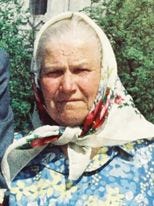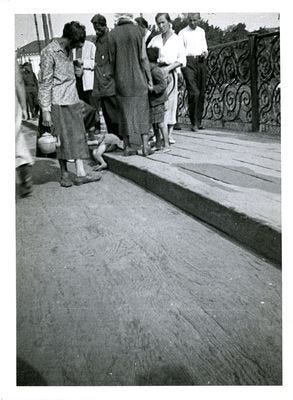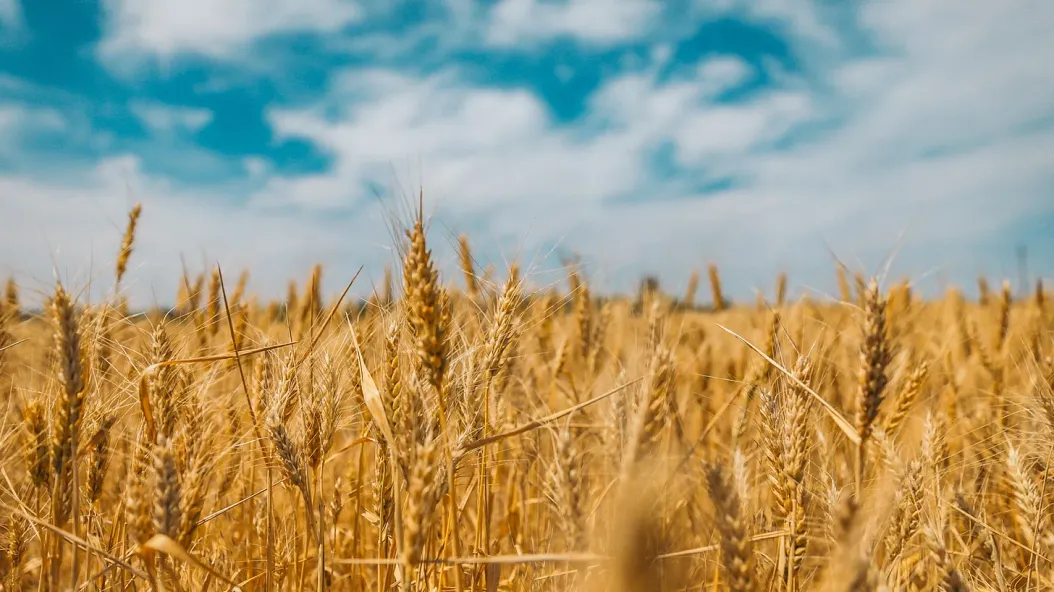Putin started this war with a story. Sitting behind a desk, he once upon a timed . Instead of a fairy tale, the story he told was an invented history. He said Ukraine was not a nation. The Ukrainians are not a people. And the not-nation and the not-people are resources that belong to his nation, to his people, to him. Some recognized this invented history as a classic Soviet story. And it is. But it is also a much older story. Older even than fairy tales. It's been told by every oppressor about, and to, the oppressed.
Putin's story started a war. Stories often do. Stories memorialize wars. As a westerner, I am keenly aware that a story about a war was told often enough, kept safe enough to survive to be one of our oldest pieces of literature. There were so many other stories from long before history began, but we don't know them. Stories about war survive, but stories also help people survive war. Stories about their homes, their families, stories about the time when there will not be war.
These stories come alive today as displaced persons are once again trying to cross into Poland. To my grandfather, it’s been a choice & a privilege to live his life in the place where he was born. He cannot bear the idea that his grandchildren might be deprived of that privilege
— Olga Boichak 🇺🇦 (@olgarithmic) February 24, 2022
Historically, women don't have listeners for their stories, in war or out of it. Oppressed women are not just unheard, they are silenced and then the oppressors tell stories about them. Sometimes those oppressors are men in palaces, like Putin. And sometimes they are women who live just down the street. And so when Russia invaded Ukraine, and there was nothing I could do, I asked for Ukrainian stories. I want us to hear them, to help others hear them. To tell them over and over and over again. I know that stories start war. But sometimes stories end war too.
Olga Boichak was born and raised in Ukraine. She is a sociologist and a lecturer in Digital Cultures at the University of Sydney, Australia. Her family - her mother, father, both sets of grandparents, aunts, uncles, and cousins still live in Ukraine. Members of her close family are being forced apart by Putin's war. Some are trying to cross over to Poland, many others are fighting against Putin, and her grandparents refuse to leave their home.
My grandparents' house is next to a major railway junction🇺🇦. It got badly hit in WWI & then again in WWII. The current house (v3) had been rebuilt by my grandfather from scratch. Today, my mother tried to evacuate them to safety, yet despite this history, they decided to stay.
— Olga Boichak 🇺🇦 (@olgarithmic) February 24, 2022
In this piece, Olga shares the story of her great-grandmother, Lydia Tverdostup. Lydia survived another Russian genocide against the Ukrainians - the Holodomor. Olga played at Lydia's house as a child. She wore Lydia's vyshyvankas when she got married. My breath catches when I think about Lydia, an ancestor now. Her people - her children, grandchildren and great-grandchildren - are facing genocide once again. Please read Lydia's story, Olga's story, this piece of Ukraine's story. And then help them all tell it by sharing it.
Olga requested I donate the money I would have paid her for this piece to Ukraine Crisis Appeal, a humanitarian aid organization. I've done that today. Instead of leaving me a tip at the end of this newsletter as so many of you often do, could you please donate that money Ukraine Crisis Appeal? Telling stories isn't enough. We need to act too.
Ukraine: Histories of Dispossession and Resilience
By Olga Boichak
Ukrainians are a resilient people. In the past few days, we saw countless reports of chaos and devastation inflicted on Ukraine by the Russian military forces. We are also witnessing Ukrainian defiance in the face of a threat: some are working around the clock to broadcast information; others are assisting with evacuation efforts to bring people to safety; still others are joining their local territorial units to defend their towns and cities if all else fails. We see videos of people stopping Russian tanks with their bare hands and putting themselves, unarmed, in front of the Russian soldiers, begging them to turn around and leave.
Losing count of IDPs I’m sheltering in Lviv. My cousin & aunt are in a bomb shelter in Zaporizhzhia. I’m drinking my morning coffee to the sound of sirens. All I feel is pride in this country. From soldiers to radio hosts & young mothers, Ukrainians, you are heroes & I love you.
— Dr Sasha Dovzhyk (@sasha_weirdsley) February 26, 2022
I thought about Ukrainian defiance and resilience as I watched Putin’s infamous speech in which he presented an outlandish alternative version of history to deny Ukraine’s claims to nationhood. He said, “modern Ukraine is in its entirety a Russian creation … nobody asked the millions of people living there what they thought”. To Putin, Ukraine is no more than Russia’s dominion, its imperial borderland. By extension, he sees its people having about as much agency as a “sack of potatoes” – thrown across national borders with no particular implications. He treats Russian people in much of the same way.
With this war, Putin is not just inflicting severe physical violence. He is also subjecting the Ukrainian people to epistemic violence. Putin is trying to destroy acountry, a culture and the people who hold the knowledge of this country and its past. Where do my people find strength when subjected to such violence? The answer is found in the history Putin is so vehemently trying to deny.
Ukrainian language and identity have long been maintained and negotiated as a radical act of resilience in the midst of deadly oppression. I know this in part because my great grandmother – Lydia Tverdostup (nee Kryvorotko) – was a Holodomor survivor. We remember her as a strong, independent, resourceful woman who radiated kindness and always knew what to do in the most difficult of circumstances.
She was highly educated and spent most of her life working as a teacher and a school principal in a small remote village of Nova Dibrova, Pyriatyn region, Poltava oblast, Ukraine. She also had impressive farming skills and throughout her life had single-handedly cultivated a large plot of land. Despite the tragic events in her life, Lydia was a powerhouse.

As a child, I once spent a summer in Lydia’s home. I still remember her neat little house with a straw roof, a clay stove, and an earthen floor; she made me dolls from mallow flowers that grew in front of her house. She was also the author of culinary masterpieces – her featherlight halushky, jumbo-size varenyky with at least a cupful of cherries each, and a large pot of borsch cooked with a whole rooster have been remembered and lovingly made in my family to this day. She also made beautiful crafts – I have been fortunate to inherit her handmade vyshyvanka, a traditional linen shirt embellished with floral embroidery. I wore this vyshyvanka on my wedding day.
Lydia never spoke about the Holodomor – an artificially engineered “death by starvation” that claimed, by conservative estimates, a death toll on a scale between 3 and 10 million Ukrainian lives between 1932 and 1933. The hunger-genocide killed up to a third of Ukraine’s population. Lydia agreed to share her daunting testimony of Ukraine’s forced industrialization only once, at my father’s request.
This oral history, recorded in my father’s handwriting in ink on a yellowing piece of paper, had been preserved in the family archive for decades before it could become part of Ukraine’s official history. Nearly every Ukrainian family had lost their loved ones in this tragedy – yet, it was forbidden to even mention it in the Soviet times. Putin’s denial of Ukraine’s history is a continuation of the Soviet Union’s genocidal policies towards Ukrainians.
Holodomor was aimed at curbing farmer resistance to Soviet collectivization policies: “At the height of the crisis, organized teams of policemen and party activists, motivated by hunger, fear, and a decade of hateful and conspiratorial rhetoric, entered peasant households and took everything edible: potatoes, beets, squash, bean, peas, anything in the oven and anything in the cupboard, farm animals and pets” (Applebaum, 2018, p. XXIV).
Lydia had vivid memories of the Fall of 1932. Her father, who was an independent farmer and owned fields, a mill, and a part of the forest, was made to surrender all of their daily output of flour to the newly appointed superintendents. Knowing he would not be able to feed his family of ten through the winter, he salvaged some of the grain by digging a makeshift storage space underneath their house. By night, they would grind a few handfuls of grain by hand. Then, they’d bake an improvised bread to get the family through the next day.
Many people in the village did not even have that. Lydia recalled witnessing numerous acts of atrocities committed against her fellow villagers in Poltava. One of these episodes involved the murder of a 5-year-old starving boy. He died under the hooves of a Soviet officer’s horse for picking a few wheat sheafs from a collective farm. Once, Lydia went to visit their neighbours, a family of nine. She found them swollen, dying of starvation, unable to leave their house. Since then, she visited them every day to share the little bread they had. Two of the neighbours perished. But seven others gradually regained their strength and made it through the winter.

While Stalin and his state apparatus were building the bright communist future, millions perished in the winter of 1932-33. Stalin ‘replaced’ them with settlers from Russia that would maintain political allegiance and uphold the Soviet rule in Ukraine. The Soviets attempted to conceal the true human costs of their industrialization project with the rhetoric of progress and development.
Plenty of people helped provide cover for the Soviets because they liked their political language. The woman who designed the first standardized, fitted kitchen was one of them. Read about her and your kitchen in my essay, By Design: White communists, socialists, feminists, and capitalists tried to engineer society using kitchen design.
The Holodomor was not the only instrument of Ukraine’s dispossession. The Soviets sought to starve Ukrainians of their cultural heritage too. In parallel with the aggressive collectivization measures in the countryside, there was another genocide happening among Ukraine’s educated elites: the Soviet secret police went after intellectuals, including academics, writers, public officials, museum curators, artists, and priests: “…anyone who had promoted the Ukrainian language or Ukrainian history, anyone with an independent literary or artistic career, was liable to be publicly vilified, jailed, sent to a labour camp or executed” (Applebaum, 2018, p. XXV).
The Holodomor - the famine in Ukraine created by Stalin - Memorial is down the street from my office.
As if you needed a reminder that Moscow has a long history of inflicting avoidable suffering and death on Ukrainians. pic.twitter.com/uRoYIef75S— Lewis Lowe 🇺🇦 (@lewisalowe) February 24, 2022
Those two policies: the Holodomor in the rural areas and the massive repressions in the urban, have been aimed at a systemic destruction of Ukrainians as a people replacing Ukrainian words with a culture of silence. Confiscating the grain and livestock used for centuries-long traditional subsistence practices undermined the Ukrainians’ self-reliance in their role as custodians of the land. Forcing Ukrainians to watch their loved ones perish of hunger was done to replace a heritage of self-reliance with obedience and fear that would be passed on to the next generations.
They could not be starved of their language, their culture or their will to continue living as Ukrainians.
Yet, as seen from Lydia’s testimonies, even in the most precarious of circumstances my people were helping each other through. They could not be starved of their language, their culture or their will to continue living as Ukrainians. Instead of fear, they’ve passed on a legacy of resilience, cooperation, and care. A legacy that could not be destroyed by the Soviet regime. It will not be destroyed by Putin’s regime either.
This history of dispossession did not end in the 1930s. It continued until the fall of the Soviet Union in 1991. Over the next 50 years following the Holodomor, Soviet leadership continued to infringe on Ukrainian language and culture through its aggressive russification policies. The Soviets carried out a systematic erasure of the Holodomor evidence by destroying local archives, manipulating the state census data and forbidding any attempts at paying homage to the victims.
In the thirty years since Ukraine’s independence, there have been several national campaigns that have collected oral histories and testimonies of Holodomor survivors from all over the country. They’ve declassified the secret archives to assist with research into this tragic page of Ukraine’s past and better estimating its human toll. Many national governments, including that of the Russian Federation, deny this deliberate act of hunger-genocide against Ukrainians to this day. This denial feeds the expansionist narratives driving Russia’s violent imperial invasion of Ukraine.
Like Stalin and Hitler before him, Putin’s imperial ambitions have already left a disastrous human toll in their wake. Those who know Ukrainian history recognize the current military invasion as an extension of a generations-long genocide of Ukrainians. But today, just like 90 years ago, we see the legacy of resilience and cooperation come alive in the face of an existential threat.
I'm a historian of this historic city being bombed. At the moment, my other friends who are historians of Kyiv and #Ukraine are hiding in subway stations and makeshift bunkers. I care for them. What comes next for them after regime change is what I dread. Help us, if you can.
— Steven Seegel 🇺🇦 (@steven_seegel) February 25, 2022
Among the people sheltering deep underground, in Kyiv’s metro stations, are historians – the keepers of Ukraine’s national memory. They understand the knowledge of Ukrainian language, culture and history must be protected. They understand that a regime change will attempt to, once again, erase the physical and epistemic violence experienced by the Ukrainians. Here’s hope that instead of contributing to a centuries-long history of violence and dispossession, 2022 will mark another historical moment celebrating the triumphant defiance and resilience of the Ukrainian people.
Olga Boichak is a Ukrainian-born sociologist and a lecturer in Digital Cultures at the University of Sydney, Australia. Her research interests span networks, narratives, and cultures of activism in the digital age. She is an editor of the Digital War journal and has a track record of publications on contemporary Ukraine with a focus on volunteering, transnational mobilization, and diasporic humanitarianism surrounding the Russian-Ukrainian war.
Meg here, again. First, a tweet from last night. Then a few thoughts.
In the Holodomer, a Soviet-made famine designed to commit genocide against Ukrainians, Ukrainian children sat down on the streets of Kharkiv and died. There are pictures of them dead on sidewalks, barefoot and bareheaded. And now Russia burns those streets and kills more. https://t.co/OR9js7VCbi
— Meg Conley (@_megconley) February 27, 2022
I keep thinking of Lydia's father hiding grain so that his family could have just enough bread to survive. And how that bread helped their neighbor's survive too. I keep thinking about Olga's father hiding that yellowing bit of paper with Lydia's testimony on it so that his family's history could survive. And how that has helped Ukrainian history survive.
Grain and history, food and knowledge - the two forms of sustenance every oppressor tries to control.
A few questions before we close:
How can we help Ukrainians store grain and knowledge as Putin's onslaught continues? And even if it stops, how can we help as the existential threat remains? How can we help every oppressed people store grain and knowledge, their food and history as they survive oppression? How can we stop oppression? How can we stop being the oppressors, the men and women down the street who do nothing to stop invasion, genocide and oppression? Abroad, yes. But also domestically. My own country has been an oppressor and waged its own genocides. We want the Russians out in the street protesting Putin and protecting the Ukrainians. And they should be. But are we protesting and protecting where we should be? A world of scarcity and oppression is a story we've told and made true. What story can we tell about a world of abundance and liberation? And how can we make it true?

